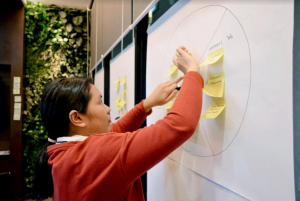Customer Persona: Best tips to get the most out of it!
At Impactivs we constantly use and love customer personas. We also train and recommend entrepreneurs to do it. We have created a Miro Template to help them with it. We realized sometimes it is not obvious how to use customer persona in the day to day business. So here are the main ways to make the most out of your customer persona (and why it is worth having them in the first place)
Now that you know How to create a user persona it’s time to understand its importance and its uses. Understanding that your customer is the main reason why our company exists, is what differentiates us from the rest. Customer Persona can be directly tied to your Target Market within your Business Model Canvas which will result in creating the best value proposition(s) for your target audience(s). Planning your operations plan, communication language and strategies, as well as identifying the best product that perfectly suits your customers are among the reasons why companies are constantly studying, analyzing and updating their personas.
We have identified five major areas where customers personas come in handy:

1.Build your value proposition
Understanding your customers’ likes and dislikes, pain points and motivations, allows you to build the most valuable product to solve their specific needs, whether it is an all-plant based gourmet restaurant or a sustainable agricultural solution to tackle the negative impact of traditional farming processes that harm the soil. In both cases, understanding who your customer is, will help you create value around your product or service. It is important to listen to your customers’ stories and analyze the quantitative data you have collected from them.
2. Create the best user experience
What is the perfect product, without providing the best design and usability? Being able to prioritize your customers key expectations in regard to your product or service, will give you an idea of the essential features your solution must include. In other words, let’s say that your customer considers decreasing time is indispensable while using your solution, the user experience will be directly tied to the time feature to consider while designing your product or solution.
Tied to the user experience is the customer journey map, a visual representation of the story you tell around the customer of how they find you and pay for your product/service. Mapping out customer touchpoints, such as your website, social media, or a link within an email.

3. Develop Products they love
The more you get to know your customer, the easier it is to build products or services they will love. This means that having a clear understanding of your customers’ problems will allow you to develop the right product to fit the market. More than just identifying a value proposition, is actually creating a customer-centered product that provides an overall satisfactory solution to your customers issues. The pain points identified within your personas will also allow you to present your value proposition within the best product for them.
4. Communicate in their language about what matters to them
Do you think that generation Z, those born between 1997 and 2012, are walking to a newsstand and picking up the newspaper on their way to work? Definitely not! Analyzing the data about your customers age, hobbies and interests, as well as their sources of information will allow you to choose the right communication channels through which you can direct your ads campaign. In other words, Generation Z is more likely to get their information from social media, such as Instagram and TikTok; online sources, like online magazines or morning podcasts. Let’s consider that your customer has the hobby of listening to a specific tech talk show through YouTube every morning, and you are considering your future marketing campaign and where to invest the budget, YouTube ads might be a perfect channel for you to communicate your products. Buyers are 49% more likely to buy from you if you personalize your content.
 5. Targeted Outreach
5. Targeted Outreach
When filling out your canvas, you might realize that you have more than one customer segment, which means that you must create the same number of customer personas. Defining these segments and their specific personas will allow you to differentiate the tone to use when talking to them (formal or informal), channels (personalized or generalized), whether it is a formal email or a LinkedIn private message. Generating a lead funnel with enough information about the type of customer you are targeting will help you design different communication strategies.
Check out our Customer Personas Template if you are ready to create your customer segments.
We hope that with this information you can make the most of your Persona and develop an effective customer-centric approach in all areas of your activity!

